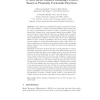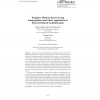154 search results - page 15 / 31 » Proving Group Protocols Secure Against Eavesdroppers |
PROVSEC
2007
Springer
15 years 3 months ago
2007
Springer
In this paper we study security definitions for authenticated key exchange (AKE) protocols. We observe that there are several families of attacks on AKE protocols that lie outsid...
IACR
2011
13 years 9 months ago
2011
Abstract. Radio Frequency Identification (RFID) systems are vulnerable to relay attacks (i.e., mafia, terrorist and distance frauds) when they are used for authentication purpose...
CIG
2005
IEEE
15 years 3 months ago
2005
IEEE
Abstract- Recently, P2P (peer-to-peer) online game systems have attracted a great deal of public attention. They work without central servers, thus, the maintenance and organizatio...
ENTCS
2006
14 years 9 months ago
2006
We present the first cryptographically sound security proof of the well-known Otway-Rees protocol. More precisely, we show that the protocol is secure against arbitrary active att...
JOC
2007
14 years 9 months ago
2007
In the security chain the weakest link is definitely the human one: human beings cannot remember long secrets and often resort to rather insecure solutions to keep track of their ...




